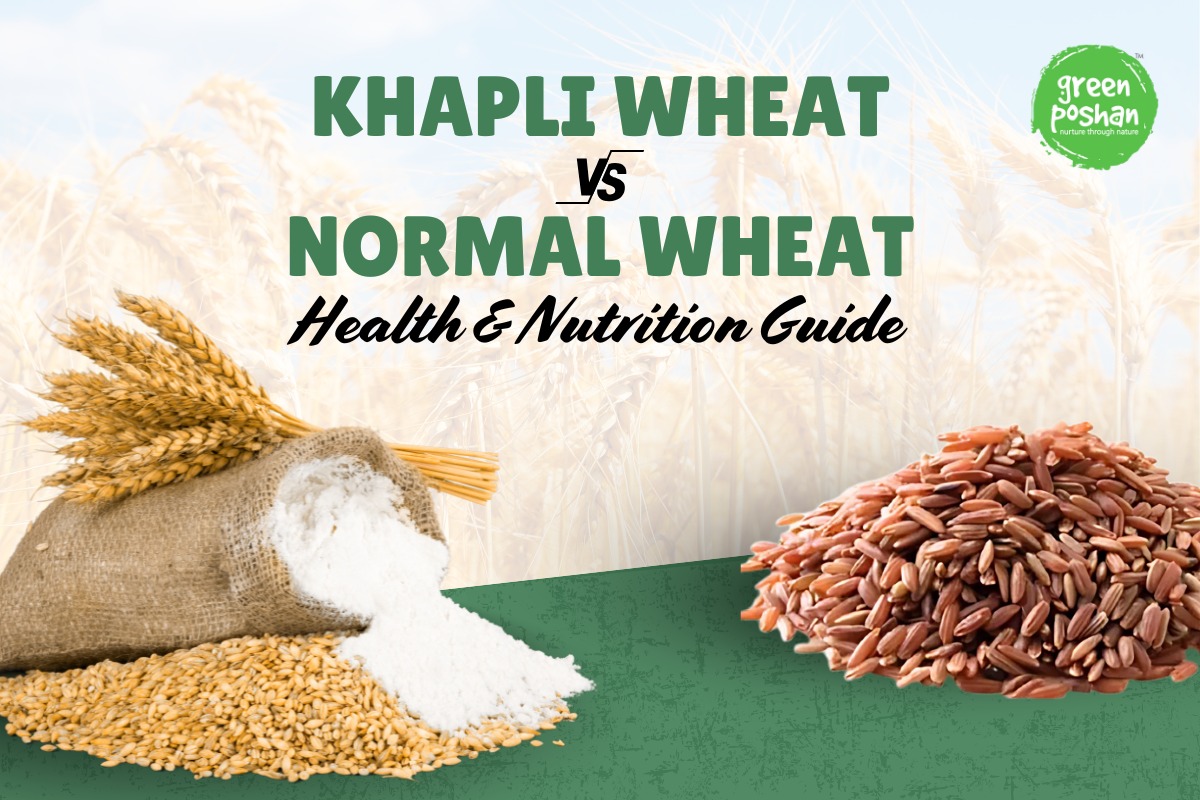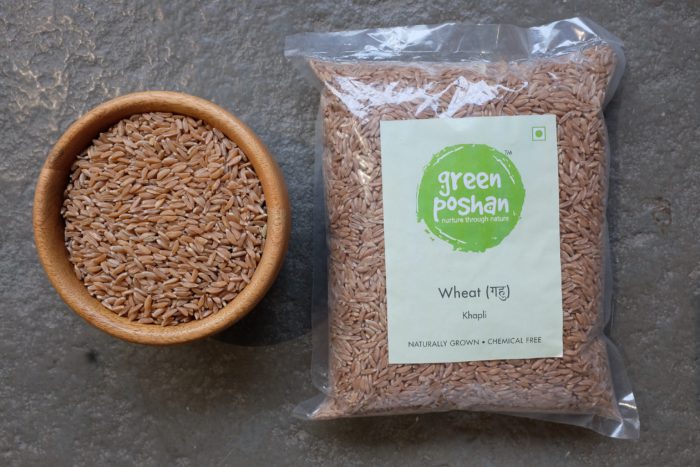If you’re looking to make healthier food decisions, understanding Khapli Wheat vs. Normal Wheat is vital. As interest grows in ancient grains for their nutrition and digestibility, this guide offers a detailed, practical comparison to help you choose the best fit for your family and lifestyle.
What is Khapli Wheat?
- Also Known As: Emmer wheat (Triticum dicoccum), an ancient Indian grain.
- Key Points:
- High in fiber, protein, iron, and magnesium.
- Lower gluten compared to regular wheat; easier to digest for some.
- Traditionally grown in Maharashtra, Madhya Pradesh, and Karnataka.
- Minimally processed, often stone-ground preserves nutrients and delivers rustic flavor.
- Cultural & Environmental Impact:
- Khapli wheat farming supports biodiversity and local farmers, helping preserve regional agricultural heritage and promoting soil health.
- Choosing ancient grains like Khapli encourages sustainable agriculture by reducing dependence on hybrid and high-input wheat varieties.
What is Normal Wheat?
- Scientific Name: Triticum aestivum.
- Key Points:
- Widely used for breads, flour (atta/maida), and packaged foods.
- Higher gluten content; soft, versatile texture.
- Commonly refined, sometimes resulting in nutrient loss.
- Background:
- Modern wheat is bred for higher yield and adaptability, but this can come at the expense of flavor, diversity, and nutrition.
Khapli Wheat vs. Normal Wheat: Nutritional Comparison
| Nutrient | Khapli Wheat (per 100g) | Normal Wheat (per 100g) |
| Calories | 340 | 360 |
| Protein | 12g | 10g |
| Dietary Fiber | 10g | 4g |
| Gluten Content | Lower | Higher |
| Glycemic Index | Low (~45–52) | High (~70) |
| Iron | Higher | Moderate |
| Magnesium | Higher | Moderate |
Values may vary by source and product. Always check packaging or ask your retailer for specifics.
Khapli Wheat — 1kg
NOTE:- For retail customer orders, weight and volume restrictions apply. If you’d like to place an order exceeding these limits, please reach out to the GreenPoshan customer care team — we’re happy to assist you!
Health Benefits: Khapli Wheat vs. Normal Wheat
Blood Sugar & Diabetes
- Khapli Wheat: Naturally lower glycemic index supports steadier blood sugar control, recommended for diabetics and those watching sugar intake. Scientific studies have reported better post-meal blood sugar responses.
- Normal Wheat: Higher glycemic index may result in quicker blood sugar spikes.
Digestion & Weight Control
- Khapli Wheat: With more than double the fiber of normal wheat, Khapli promotes digestive health, supports gut microbes, and helps control appetite and weight.
- Normal Wheat: Less fiber, especially in refined forms, provides less satiety and digestive support.
Protein, Micronutrients & Gluten
- Khapli Wheat: Higher protein, iron, and magnesium content benefit muscle health and immunity; lower gluten makes it easier to digest for some (though not gluten-free unsuitable for celiac patients).
- Normal Wheat: Sufficient protein for daily needs, but higher gluten may cause issues for gluten-sensitive individuals.
Enhanced Value: Real-World Tips & Practical Use
Who Should Choose Which?
Khapli Wheat:
- People managing diabetes or seeking lower-GI foods.
- Individuals focusing on weight management or improved digestion.
- Those exploring ancient grains or reducing gluten without needing a gluten-free diet.
- Eco-conscious buyers interested in biodiversity and supporting Indian farmers.
Normal Wheat:
- Those seeking convenience due to widespread availability and softer texture.
- Families used to traditional wheat breads and everyday recipes.
Easy guide to incorporating Khapli wheat to daily meals
- Start Gradually: Mix Khapli wheat flour with normal wheat flour for rotis or breads, increasing Khapli content over time.
- Hydration: Khapli dough may need slightly more water due to higher fiber content mix slowly to reach the right consistency.
- Recipes: Try Khapli in rotis, dosas, or as a base in salads and khichdi. Many prefer its nutty flavor and hearty texture in traditional Indian dishes.
Basic Storage & Freshness Guide
- Store Khapli wheat (whole or flour) in airtight containers in a cool, dry place.
- For best freshness, buy flour in small quantities or mill whole grains as needed.
- Check for organic certifications and batch dates before purchase.
Quick Recipe Example: Khapli Wheat Roti
- Mix 1 cup Khapli wheat flour with water, pinch of salt, and knead to a soft dough.
- Let rest for 10 minutes; roll into rotis.
- Cook on a hot tawa until golden brown.
- Serve with seasonal vegetables or curd.
How to Identify Authentic Khapli Wheat
- Elongated, golden-brown grains often labeled as “Emmer” or “Triticum dicoccum.”
- Buy from transparent, certified brands that provide sourcing details.
- Request lab reports or certificates of purity for added confidence.
Frequently Asked Questions
Q. Is Khapli wheat gluten-free?
A. No, it is lower in gluten but not gluten-free.
Q. Can I use Khapli wheat every day?
A. Yes, unless you have celiac disease or a diagnosed wheat allergy consult your doctor for dietary changes.
Q. Is Khapli wheat more expensive than regular wheat?
A. It can cost more due to limited production and traditional farming methods, but many find the health and environmental benefits worth it.
Q. Can Khapli wheat be used for cakes and bread?
A. Yes! It’s denser and nuttier, so experiment with hydration and rising times.
Myth-Busters
- Myth: Khapli wheat is always organic by default.
Truth: Only buy from brands showing proper certifications for chemical-free farming. - Myth: Lower gluten means no risk for gluten-sensitive people.
Truth: Khapli may be easier for some, but it’s not safe for those with celiac disease.
Environmental & Farmer Benefits
- Consuming heritage grains like Khapli helps keep traditional farming profitable, reduces reliance on chemicals and monocultures, and supports regional biodiversity.
- By purchasing Khapli wheat from brands like GreenPoshan, you help promote ethical sourcing and empower local communities.
Wrapping Up
Switching to Khapli wheat can offer better nutrition, improved digestion, and support for healthy blood sugar, while also benefiting the environment and indigenous agricultural practices. For those seeking an ancient, natural, and nutrient-dense grain, Khapli wheat is a top choice.
Ready to try?
Explore certified Khapli wheat for authentic taste and enhanced health change your health journey, one grain at a time.
For further health or diet questions, always seek guidance from a qualified nutritionist or dietitian. Adding heritage grains to your diet can be a delicious and rewarding way to embrace better nutrition and sustainability.


